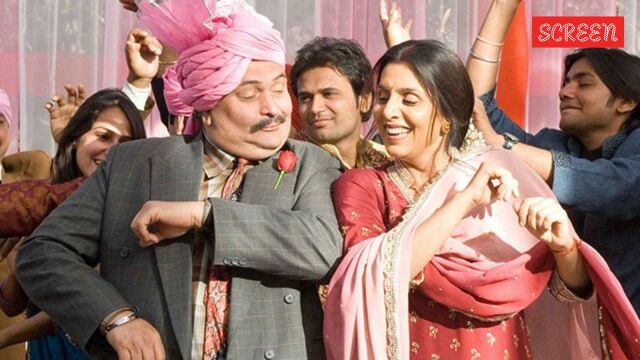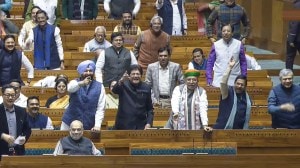Click here to follow Screen Digital on YouTube and stay updated with the latest from the world of cinema.
‘Neetu Kapoor played a big role in reining in the brat within Rishi Kapoor’, recalls Do Dooni Chaar director Habib Faisal
In an exclusive conversation with SCREEN, filmmaker Habib Faisal opens up about his directorial debut Do Dooni Chaar, learning filmmaking from Rishi Kapoor, and the autobiographical roots of the story.
 The film effectively depicted the resilience of middle-class Delhiites.
The film effectively depicted the resilience of middle-class Delhiites.Fifteen years ago, Habib Faisal made his directorial debut with Do Dooni Chaar; a small, tender slice of middle-class life set in the national capital. The film starred Rishi Kapoor and Neetu Singh as the Duggals, a couple wrestling with aspirations that stretch beyond their modest means. That same year, Faisal also contributed to another Delhi story, Band Baaja Baaraat, a vibrant tale of young ambition. Yet, where that film pulsed with youthful hustle, Do Dooni Chaar found its heartbeat in the weary resilience of age — in two seasoned dreamers still chasing decency and dignity amidst the chaos of the city.
Kapoor and Singh brought a lived-in warmth to their roles, the comfort of shared struggle, the humor of small defeats. Perhaps that’s why the film endures: it glows with the same grace as the middle-of-the-road cinema of Basu Chatterjee or Sai Paranjpye, stories of everyday goodness. In an exclusive conversation with SCREEN, Faisal recalls making a film rooted in his own memories, at a time when Hindi cinema still had space for such stories of people who measure success not in what they have, but in how they hold on to who they are.
Excerpts edited for clarity and brevity
When was the last time you watched the film?
I’m not sure. I haven’t seen it in quite some time.
Although you haven’t seen it recently, do you think the film holds up well with the current times?
Honestly, I can’t say that about my own film. But when I see other films, like recently when Robert Redford passed away, I felt so emotional that I went back and watched The Sting and Butch Cassidy and the Sundance Kid. With Butch Cassidy, specifically, I realized that apart from the sound, which feels a bit dated, the visual grammar, storytelling, and pacing haven’t aged at all. It still feels so young. I can’t say the same about my own film, it’s hard to watch your own work purely as a viewer. You notice the mistakes, the things you wish you could have corrected but didn’t get the chance to. So I think others are better judges of how well it holds up. Still, I believe the people in it, Rishi Kapoor, Neetu Singh, and the kids, have a timeless charm. Because even now when you watch the remake of Some Like It Hot, Rafoo Chakkar, which they both did, or even their songs, they just still look so fresh, and lively. So, I’m hoping, that quality of theirs would surely keep the film fresh. And its themes of middle-class life and aspirations remain relevant even today.
While watching the film, I felt it could be seen as a companion piece to Khosla Ka Ghosla, which came out a bit earlier and explored similar middle-class morality. Was that a conscious reference point while making this?
I’ve grown up on Hrishikesh Mukherjee and Basu Chatterjee films. So my worldview, especially in dealing with conflicts, has been shaped by their kind of cinema. Similarly, in literature, the one story that has always stayed with me is Premchand’s Eidgah, for its fluid storytelling, character building, and the ease with which it handles complex human conflicts. That’s part of my DNA, so to speak. I don’t exactly remember the timing of Khosla, but that film was approached more from the younger generation’s perspective. There’s certainly an overlap in space and texture, but Do Dooni Chaar was clearly about the Duggal parents. They are the heroes of my film. I’ve also said before that, in many ways, the film is autobiographical, it reflects my own discovery of my father and is built around my parents and the environment I grew up in. So the reference wasn’t any existing movie or story, but rather my own life and experiences.
 Habib Faisal described the film as autobiographical, saying it was inspired by how his perception of his parents evolved over time.
Habib Faisal described the film as autobiographical, saying it was inspired by how his perception of his parents evolved over time.
What was Rishi Kapoor’s reaction to the script when you approached him?
He was very honest about one thing, he said he didn’t know this space at all and had never performed such a role before. But what he connected with were the relationships and emotions. For instance, his bond with his sister, which drives him to borrow a car and travel all the way to Meerut to please her. And more broadly, the simple journey of buying a car, that challenge intrigued him. Until then, most of his narratives were driven by romance, falling in love and its conflicts. But here, the need and want were different: the happiness of the family. Finding joy for himself through his family’s happiness, that’s what truly connected with him.
In terms of performance, this new kind of character became a challenge he completely surrendered to the script, me, and the entire process. After the film, some fellow directors asked how it went so smoothly with him, and I believe it was because he embraced that challenge fully. And he also really enjoyed being in Delhi. Most of our ADs, crew, and cast were from Delhi, except him and Neetu Singh. Everyone spoke pure Delhi lingo, which he loved. The actor in him was thrilled by the local cadence. Often, just before a take, he’d ask our AD, Sumit Tyagi, to say his lines in that Delhi tone, and then he’d deliver them exactly like that in the shot. At the same time, he did have some anxiety, wondering how audiences would react to seeing him and Neetu Singh together again, and whether people would come to the theaters. But that didn’t deter him; if anything, it made him more excited about the film.
How was it working with Neetu Singh?
Her presence was phenomenal. She was instrumental in providing balance and reining him in because he could be a bit bratty at times. For instance, before shooting began, I went to their house and suggested they come two days early so we could do readings on set. I thought it would help break the ice with the rest of the cast, especially the kids, and help everyone stop being “stars” and become their characters. He instantly refused, saying, “I don’t do readings and all.” But Neetu Singh said, “I’m going. You don’t want to, but I’ll go.” So he ended up coming with her. By nine in the morning, they were there while we were setting up. He walked around, looked at the fridge, the helmet, the table, the stove, the cooler, everything, and slowly got into the zone. We started reading, and since he’d refused, I began reading his part. After a while, he joined in and said, “Okay, now I’ll do it.” That was Neetu Singh’s influence, she always managed to rein in the brat in him. But I must say that I learned a lot about filmmaking from him.
Can you elaborate on that?
He said wouldn’t do live sync sound. Because he came from the dubbing era and was confident he could do a great job in dubbing. And, our budget was small, and using sync sound equipment would’ve increased costs. Because of his insistence, we couldn’t use sync sound, so we had to dub the entire film. And, you can’t just dub for one character; everyone has to. That turned out to be an amazing learning experience for me. Each time we dubbed for a character, I ended up watching the whole film from that character’s perspective. It really helped me in editing, noticing where a scene dragged, where it needed more space or energy. Since we didn’t use live sound, every bit of sound was designed from scratch, and that process became my sound schooling, in a way. Even though my next film was sync sound, I was far more aware of how to use sound effectively, and that awareness came entirely from this experience.
 Habib Faisal recalls how Rishi Kapoor was thrilled by the challenges that the character presented.
Habib Faisal recalls how Rishi Kapoor was thrilled by the challenges that the character presented.
Back in the day, there were also reports of you doing a sequel.
Not exactly a sequel, but I did have several stories around the Duggal family. However, I got into a contract with YRF, and since Do Dooni Chaar was a Disney film, I had to wait for some time. Then life took its own course, and unfortunately, Rishi Kapoor is no longer with us now. But yes, those stories still exist, I’ll get to them when the time is right.
Do you think you can make a film like this in today’s commercial landscape?
See, even back in the day when this film was being made, there were doubts about whether it would work with audiences or not. Of course, now there are many more avenues, especially with streaming platforms. In recent times, several kinds of films have done very well in that space, you see a film like Pagglait performing beautifully. So, I can’t say for sure whether something like this would work or not — it surely can. The real question is whether someone would be willing to make it. That’s where things have become more complicated. The instinctive excitement to back a story still exists, but it’s become more “excel-sheeted,” so to speak.
You keep trying. The audience is still very much there, that I’m pretty sure about. It’s also about making it on the right budget. All these kinds of films worked because they were made within the right budgets. But in the last few years, films set in the same middle-class space have become mainstream, and that has made things more expensive, the whole Ayushmann phase, for instance. So as long as such films are made at the right scale and budget, I have a lot of hope that audiences will continue responding to them. As for the financing and economics, I’m no expert, but as a filmmaker, I believe things go through ups and downs, and eventually, they find their balance.
- 01
- 02
- 03
- 04
- 05


































